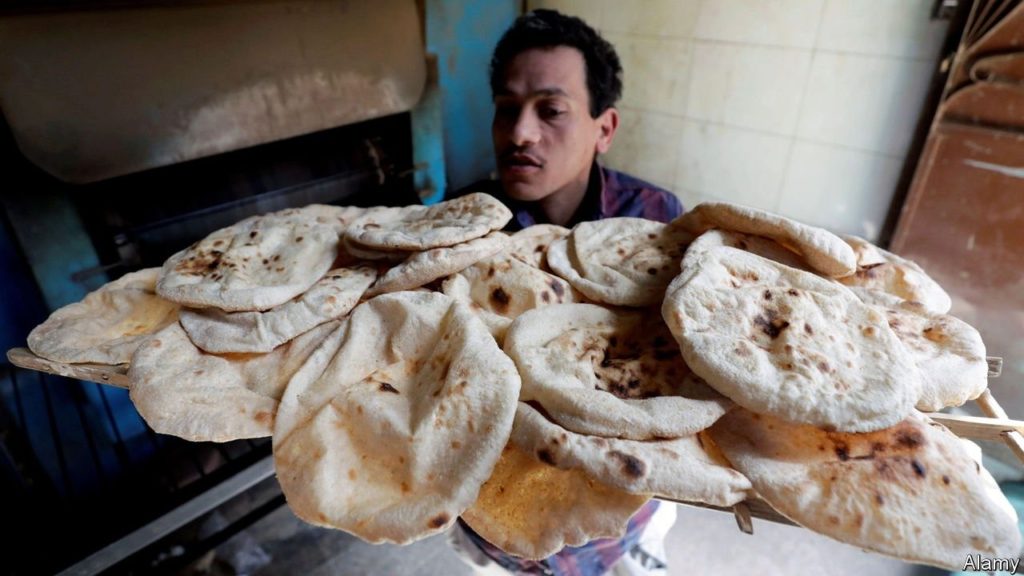
DUBAI, JOHANNESBURG AND PARIS — THE LAST time Egypt raised bread prices, the Soviet Union was still intact. Since 1989 subsidised bakeries have offered 20 loaves of aish baladi, a glutinous pita that is the country’s staple, for one Egyptian pound. Back then that sum was worth almost $1. Today it is worth about six cents, less than a tenth of what it costs to produce the bread.
The state spends 45bn pounds ($2.9bn) a year to make up the difference, more than half its total food-subsidy bill. No government has dared tinker with this generous, expensive arrangement. Bread is the main source of calories for millions of Arabs, and thus one of the most sensitive issues in politics. In past decades higher prices led to riots in Egypt, Jordan, Morocco, Tunisia and elsewhere.
Russia’s invasion of Ukraine, which has sent commodity prices surging, may compel Arab governments to think the unthinkable. Costly wheat will blow up budgets in the Middle East, perhaps forcing subsidy cuts that leave citizens hungry. Across sub-Saharan Africa, higher oil prices will strain budgets that are already creaking under the burden of a debt splurge.
All this may mean not just hardship, but also unrest. President Anwar Sadat tried to do away with Egypt’s bread subsidy in 1977; he reversed his decision within days, after riots that had to be quelled by the army. Ethiopia’s revolution of 1974 followed an oil-price shock, which saw taxi drivers take to the streets in protest. Higher food prices in 2008 and 2009 helped set off the revolts of the Arab spring, and protests that eventually led to the toppling of Omar al-Bashir in Sudan in 2019. Many Arab and African governments have refused to express support for either side in the current conflict, arguing that it is not their war. They will soon feel its effects nonetheless.

Start with wheat, of which Russia and Ukraine are, respectively, the biggest and fifth-biggest exporters in the world. The war has, in effect, halted shipments from the Black Sea; it may also imperil the spring planting season in Ukraine, which is due to start in April. That is dire news for Egypt, the world’s largest wheat buyer. It needs 21m tonnes each year to feed its 102m people but produces less than half of that amount. Some 86% of its imports are from Russia and Ukraine (see chart).
This year’s budget assumed that imports would cost $255 a tonne. Prices on futures markets are already flirting with $400. That could add at least $1.5bn (0.4% of GDP) to Egypt’s import bill. The price of unsubsidised bread, often of better quality than the discounted stuff, has increased by 50% in some shops in recent days.
Abdel-Fattah al-Sisi, Egypt’s authoritarian president, has never liked the bread subsidy. “It’s unreasonable to sell 20 loaves of bread for the price of one cigarette,” he said last year. Soaring prices would give him an excuse to try to change it. But he may not like the reaction. Almost one-third of Egyptians live below the paltry official poverty line of 857 pounds a month. Squeezed by years of higher taxes and cuts to energy subsidies, they are in no position to spend more on their staple food.
Many of Egypt’s neighbours are in a similar bind. Fadhila Rabhi, the Tunisian trade minister, says subsidised baguettes that sell for 190 millimes ($0.06) already cost 420 millimes to produce. The country is ill-equipped to cope with a higher subsidy bill. It has a fiscal deficit of around 9% of GDP and annual debt-service payments at around the same level. In Lebanon, mired since 2019 in a financial crisis, the price of a bag of flatbread had already increased by more than 400% in the two years before the war. Lebanon’s main grain silos were destroyed in an explosion at Beirut’s port in 2020, leaving the country able to store only a month’s worth of wheat; the economy minister has been reduced to begging rich countries to fund imports that cost $20m a month.
The list goes on. A drop in maize shipments from Ukraine, the world’s fourth-largest exporter, could hurt Egypt, which gets 26% of its maize imports from there. Because most of it is used for animal feed, higher maize prices will lead to more expensive meat in Egypt, and pricier maize porridge in southern Africa, where it is a staple. Cooking oil is also becoming more expensive because Ukraine is the world’s biggest exporter of sunflower oil. Soaring prices are spilling over into substitutes such as palm oil, a staple in west Africa, and driving up food-price inflation across the Middle East and Africa. In January the UN’s vegetable-oil index touched its highest level ever, while palm-oil hit record highs on futures markets this month.
Disruptions in Ukraine will also hit some of Africa’s fastest-growing countries, many of which have already been slammed by soaring inflation. Across sub-Saharan Africa food makes up roughly 40% of the consumer-price basket. Food inflation, which had been running at about 9% a year in 2019-20 across the region, started ticking up a year ago to reach about 11% in October because of rising transport, oil and fertiliser prices and disruptions to farming from the pandemic. The first to be hit by higher wheat prices will be the likes of Ghana and Kenya, where the staple accounts for about one-third of cereal consumption, or Nigeria, where poorer urban families slurp a lot of instant noodles.
Higher food prices hurt the urban poor most of all, since they tend not to grow their own. This matters for political stability. Urbanites are more densely packed and closer to the seat of government than their rural cousins. So riots in cities can overthrow governments.
Rural folk might in theory benefit from higher food prices, since many of them sell food as well as eating it. Subsistence farmers are a higher share of the population in sub-Saharan Africa than in the Middle East, and not especially reliant on imports of food. Yet even they will be hurt by higher prices for fertiliser and transport. The cost of ammonia, a key input for fertiliser, had already shot up by 260% between December 2020 and December 2021, says Wandile Sihlobo of Stellenbosch University in South Africa. Reduced shipments from Russia and Belarus, both big exporters, will boost prices further.
Oil in the mix
Pricier crude oil is a mixed blessing for the Middle East. At current prices all the region’s oil exporters, save Algeria, should be able to run both fiscal and current-account surpluses. Many Gulf governments have reduced fuel subsidies in recent years—motorists in the United Arab Emirates are paying 3.23 dirhams ($0.88) a litre this month, a record high—which will cushion the blow to state budgets. For importers, of course, there is nothing to celebrate. Petrol prices in Lebanon have climbed by 17% since late February, and 20 litres of petrol now cost about two-thirds of the monthly minimum wage.
The picture is worse in sub-Saharan Africa, where 38 of 45 countries are net oil importers. Higher prices will be a “very significant” negative shock, warns Abebe Aermo Selassie, the director of the IMF’s Africa department. Even at the best of times most African countries struggle to export enough to be able to cover the cost of their imports. A thumping increase in the oil price will cause real balance-of-payments trouble across the continent. Well before prices started rising, petrol already accounted for about 20% of imports in Kenya and Ghana.
An immediate consequence will be higher inflation. Transport prices were already the biggest cause of headline inflation (which includes food and energy) in Kenya, Ghana and Rwanda last year. In Nigeria, where annual inflation is running at close to 15%, transport and food costs, both of which are spiking, make up 57% of the inflation index.
The few African countries that produce oil, such as Nigeria and Angola, stand to benefit. However, even they may do less well than hoped, at least in the short run. Both countries subsidise petrol for consumers. The bill for that will balloon, eating into government revenues and leaving less to spend on education and health. Fuel subsidies could now cost the government of Angola the equivalent of about 2% of GDP, up from an expected 1.4%. In Nigeria they may also reach 2% of GDP, up from about 0.8% last year. Nigeria’s plans to reform its petrol subsidy, already on hold because of rising prices and pressure from unions, will be knocked back further.
Better news may come only in the medium term. Europe is on a desperate hunt for non-Russian oil and gas. Algeria, which has pipelines to Spain and Italy, is looking to take advantage. Other African producers hope to cash in by shipping more liquefied natural gas (LNG).The big prize would be European support for one of two mooted gas pipelines that, in time, could link Nigeria to Morocco and go on to Europe, or Nigeria to Algeria through the Sahara. Long something of a pipe dream, an end to European reliance on Russian gas could make the unthinkable suddenly possible.
For years Arab autocrats have sought closer ties with Vladimir Putin. Whereas America lectured them about human rights, Mr Putin urged strongmen to be strong. When he visited Cairo in 2015, for the first time in a decade, he gave a Kalashnikov to Mr Sisi, who in turn treated him to dinner at a restaurant overlooking the Nile (with plenty of bread on the table). Now those same autocrats face broken budgets and angry citizens—courtesy of Mr Putin.
By The Economist




